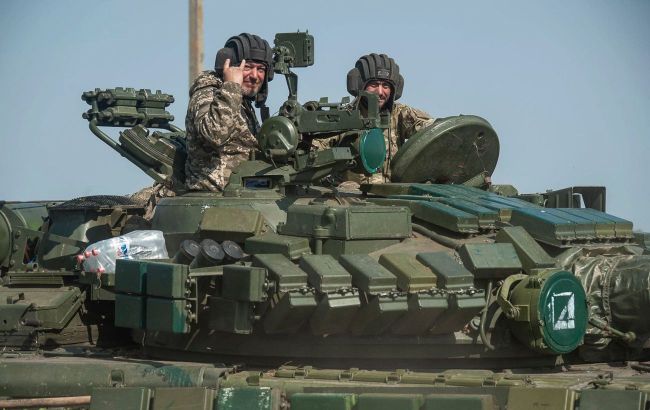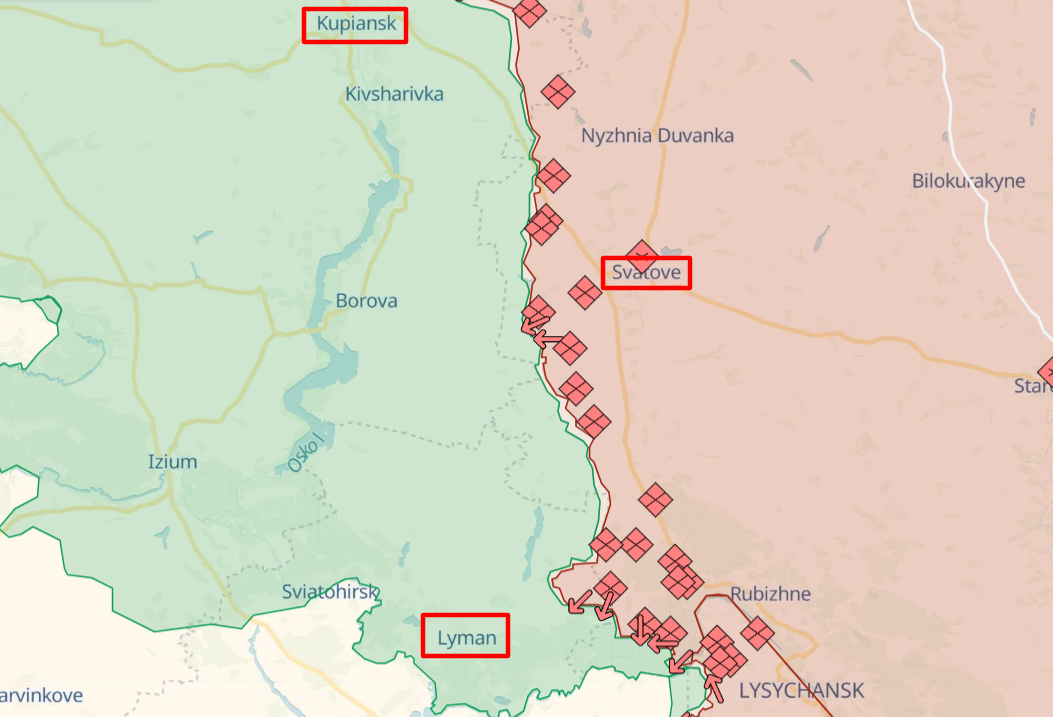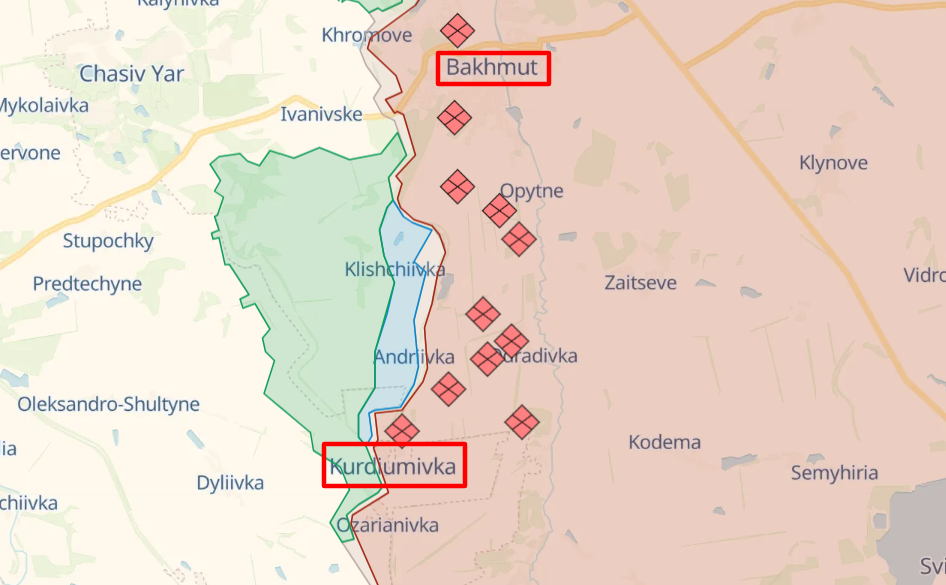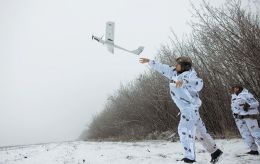Ukraine preparing ground for new battle for Bakhmut: Frontline overview
 Photo: Ukrainian troops are achieving success in the south and near Bakhmut (photo facebook.com/MinistryofDefenceUA)
Photo: Ukrainian troops are achieving success in the south and near Bakhmut (photo facebook.com/MinistryofDefenceUA)
Ukrainian forces are achieving success to the south of Bakhmut and in the direction of Tokmak, simultaneously increasing the intensity of strikes on Russian targets in Crimea. For the situation on the front and the prospects of a counteroffensive, read the overview by RBC-Ukraine.
During the preparation of this material, the following sources were used: analysis from the Institute for the Study of War (ISW) and the DeepState project, an interview with the Chief of the Defense Intelligence Kyrylo Budanov by The War Zone, an interview with the commander of the Operational Strategic Troop Group Tavria Oleksandr Tarnavskyi by CNN, data from the General Staff, British intelligence information, President Volodymyr Zelenskyy's statement, and comments from military experts for RBC-Ukraine.
Lyman-Kupiansk axis. Calm before the storm?
The Russian summer offensive campaign along the Kupiansk-Lyman line has failed. Since mid-September, there has been relative calm here, but it is unlikely to last long.
Over the summer, the occupiers managed to take Masyutivka in the Kupiansk area, pushing the front line to the outskirts of the village of Synkivka. Operational reinforcements thwarted Russia's attempts to advance further.
Further south, the enemy occupied the Kuzemivka station and parts of Novoselivka. In the Novoiehorivka area, they engaged in battles with a large number of infantry and equipment, but additional reinforcements halted their progress in all cases. This situation is similar to the situation in the Serebryanskyi Forest near Lyman, which the enemy has been assaulting throughout 2023. Here, they accomplished two objectives - creating a buffer zone for Kreminna and approaching our forces from three sides in Bilohorivka.
 The Lyman-Kupiansk axis remains stable for now, but the Russian offensive could resume at any moment (Photo: deepstatemap.live)
The Lyman-Kupiansk axis remains stable for now, but the Russian offensive could resume at any moment (Photo: deepstatemap.live)
As of today, the situation is stable, but enemy forces are increasing artillery shelling. According to analysts, without a significant increase in personnel and rapid replenishment, they have virtually no chance of achieving strategic success. As the Chief of the Press Service of the Military Group East of the Ukrainian Armed Forces, Illya Yevlash, says, they are currently gathering forces for new attacks.
"New recruits are being assembled from those we managed to gather. We can't speak of their high quality," he noted.
Preparations are underway on the Lyman-Kupiansk axis for the newly formed 25th Russian Army and assault units, which will be used for breaking through the Ukrainian defense. Military expert and former Chief of the General Staff Press Service Vladyslav Seleznov draws attention to publications from Russian opposition channels. They report that Vladimir Putin doesn't want to hear bad news from the front lines until October.
"It's clear why, as he has his birthday on October 7, and he needs some good news. Most likely, we will soon see a serious intensification in the Lyman-Kupiansk direction. By the way, the offensive was planned for September 26-27, and Ukrainian intelligence indirectly confirmed that the enemy was preparing to advance. There is information that the Russians are creating passages in their minefields and moving equipment closer to the front line. If the army were on the defensive, they wouldn't be deploying infantry fighting vehicles and tanks closer to the front. It seems that they are creating a 'tank fist' to push back our defense forces," he explained in a comment to RBC-Ukraine.
Bakhmut is getting closer, but the encirclement is still far away
In September, the Ukrainian Armed Forces gained control over Andriivka and Klishchiivka, two key villages south of Bakhmut. Currently, they continue to push the enemy eastward along the railway. The positions along the T0513 highway between the occupied Bakhmut and Horlivka are likely to be the next significant obstacle. This is one of the crucial logistical routes for the Russians, but not the only one.
According to Illya Yevlash, the enemy is attempting to return to positions around Klishchiivka and Andriivka, but our forces are repelling attacks, consolidating, and continuing their advance on the southern flank. He confirms recent successes and states that the Bakhmut-Horlivka highway is already partially under fire control.
"We can already hit it; it's a road that is about 3 km away from the front line. It's a working distance for our mortars and drones," he said, adding later that they have managed to liberate another 2 square kilometers of territory near Bakhmut in a week.

Bakhmut is getting closer, but the encirclement is still far away (Photo: deepstatemap.live)
Expert Vladyslav Seleznov acknowledges that progress is challenging because the enemy has a significant advantage in the aviation component. However, their logistics are partially under our fire control, which is good news. But it is still a long way before the Russian garrison in Bakhmut is left without supplies, let alone the city's blockade. Making predictions about the timeline is not appropriate.
"We don't know if we have enough resources to continue pushing the Russians, displacing them to the east and creating conditions for the operational encirclement of Bakhmut. There is no information in open sources about the capabilities of the Ukrainian army in this area. We know that about 52,000 Russian troops are concentrated here. We are gradually eliminating them, but I believe they still have enough resources to slow down our eastward movement," he noted.
Recently, Chief of Defense Intelligence Kyrylo Budanov explained how Ukraine plans to return to Bakhmut in an interview with The War Zone. According to him, the liberation of Klishchiivka secured control over dominant heights, and next will be cutting off supply routes, followed by the entry of forces into the city. There will definitely be no frontal assault.
Looking at the map of the ongoing operations, a lot of work remains to encircle Bakhmut. According to military-political analyst Oleksandr Kovalenko from the Information Resistance group, before physically cutting off the Bakhmut-Horlivka highway, it is necessary to liberate a small agglomeration near Kurdiumivka, south of the mentioned villages.
"Fire control is good, but we will physically cut off the road. It requires advancing 2 to 3 km through Russian positions in the lowlands. After the Russians cease their suicidal attacks on Andriivka and Klishchiivka, the defense forces will move toward T0513. After gaining full control over the highway, the issue of Zaitseve and more will be resolved," he explained.
He also suggests that in an attempt to halt the advance, the Russians may shift forces from the northern flank to the southern one. In that case, their defense in the south would weaken, facilitating the encirclement of Bakhmut from the north. However, the expert emphasizes that one can only speak of an encirclement after the Russians are cut off from all roads.
"If at least one road remains operational, even under fire control, it's not an encirclement. And I'm not just talking about the main highways to Debaltseve and Pervomaisk, but also the roads through Bakhmut, Pokrovske, and so on. It's worth mentioning that when we were on the defensive, we fought to the last to keep control of the T0504 road (to Kostiantynivka) and T0506 through Khromove. When the enemy managed to put the road under fire control, we took field roads and reached the main road from the almost encircled Bakhmut," Kovalenko explained.
Southern front. The movement continues, and the area of control is expanding
In the Zaporizhzhia region, the army achieves small successes almost daily. Judging from the DeepState map, the liberated territory increases after each update. The defense forces continue to close the gap between the villages of Novoprokopivka and Verbove as battles rage on the outskirts of both settlements.
In an interview with CNN, the commander of the Operational Strategic Troop Group Tavria, Oleksandr Tarnavskyi, mentioned a breakthrough near Verbove. However, he acknowledged that progress is slower than expected, nothing like in the movies about World War II.
"On the left flank, we have a breakthrough, and we continue to advance... The main thing is not to lose the initiative," he noted.
The breakthrough near Verbove has a tactical nature and is unlikely to fundamentally change the situation. The Russians have deployed reserves from at least four airborne divisions here, and these forces are attempting to attack from the flanks, explained expert Vladyslav Seleznov.
"Most likely, Tarnavskyi's headquarters will implement a strategy of gradually grinding down the enemy's resources. Our army systematically destroys their artillery, armored vehicles, and personnel. What comes next? I am confident that until we eliminate the units that replaced those who held the defense on the 'Surovikin Line,' there will be no opportunity to actively move forward. I believe that in the near future, we will focus on destroying their combat potential," he said.
According to the General Staff's data, battles are ongoing on collision courses, but Ukrainian forces are pushing back the enemy and consolidating on new frontlines. According to the spokesperson of the defense forces of the Tavria direction, Oleksandr Shtupun, they manage to advance from 50 to 100 meters daily, inflicting heavy losses on the enemy.
According to Oleksandr Kovalenko, it's too early to talk about a near culmination of the counteroffensive in the south. Besides Verbove and Novoprokopivka, there are successes in the direction of the villages of Novofedorivka and Kopani, and each of them brings the breakthrough closer to the second line of the Russian defense.
"The main goal is to reach Tokmak on the T0408 highway, of course, liberating Novoprokopivka, Ilchenkove, and Solodka Balka on the way. Control of the logistical artery 0408 will allow us to reach the northern gates of Tokmak. What happens next could range from encirclement to the city's de-occupation. For us, it's better if the Russians retreat because encirclement will require significant forces and take more time," the expert noted.
ISW analysts list several conditions for a breakthrough on the southern front. Among them, it must be confirmed that the occupiers lack the strength for long-term defense, Ukrainian forces maintain sufficient combat readiness, and the Russian lines in the current area of operations are not as heavily mined and fortified as those that have already been breached.
General Tarnavskyi assured that the biggest breakthrough is yet to come and will occur after Tokmak. He also hinted that Tokmak remains at least a minimum objective of the current counteroffensive. This is corroborated by the increased frequency of airstrikes and reports of the destruction of a Russian observation post near the city.
Experts interviewed by RBC-Ukraine agree that at least in the perspective of this year, the Ukrainian army will aim to reach Tokmak. Why is this important? An important railway line connecting Melitopol with Volnovakha passes through the occupied city in the Zaporizhzhia region. Once it is cut off, the enemy will have only a coastal road along the Azov Sea, preventing rapid transportation of large military supplies.
"If we manage to reach the south of Tokmak in October, we can accelerate the advance on Melitopol. Then, worsening weather, autumn rains, will not be critical for us. If we are near Melitopol or at least on the way to it from the side of Tokmak," Kovalenko added.
"Crab Trap" for the Russian Black Sea Fleet
Recent events have shown that there are no safe places left for the Russian army in Crimea. The most prominent incident was a missile strike on the headquarters of the Russian Black Sea Fleet in the occupied city of Sevastopol.
The operation, codenamed "Crab Trap," was carried out with the involvement of Special Operations Forces. Details are not disclosed, but thanks to their work, the Air Force launched an attack on the headquarters with two Storm Shadow missiles at the moment when a meeting of high-ranking officers was taking place there.
According to the Ukrainian side, 34 officers were eliminated, including Vice Admiral Viktor Sokolov, the commander of the Russian Black Sea Fleet. Another 105 occupiers were injured, and the headquarters building is beyond repair. It is noteworthy that the strike was precise, and the occupation authorities claimed no civilian casualties. The elimination of Sokolov is a historic event, as the last commander of the Russian fleet to die in battle was Vice Admiral Stepan Makarov in 1904.
However, yesterday, the Russian Ministry of Defense published a photo of Sokolov at a meeting with Sergei Shoigu. Therefore, information about his elimination is still being clarified.
According to General Tarnavskyi, strikes against Russians in Crimea and Sevastopol are crucial for the success of the Ukrainian counteroffensive. This is because it involves not only destroying the enemy in front but also hitting their equipment, personnel, and command centers.
Vladyslav Seleznov reveals the strategic significance of this strike. Firstly, the elimination of the command disrupts military management, and secondly, the occupiers will need time to restore communications and reliable communication.
"And we understand that if strikes on the headquarters have already occurred twice, such 'thuds' will continue in the future. Judging by the recent dates, alarms and explosions are constantly happening over Sevastopol and in various parts of Crimea. So, the Ukrainian army is preparing the ground for a new battle. I am not ready to say that Ukraine will de-occupy Crimea in the near future. I do not have access to the General Staff's plans, and it is difficult for me to imagine how this can be implemented," he told RBC-Ukraine.
Oleksandr Kovalenko believes that there are currently no conditions for land battles to move to the peninsula this year. To begin with, it is necessary to reach the administrative border and isolate the Russian grouping from the mainland through both the Crimean Bridge and maritime routes.
"At the same time, we can reduce the combat potential by striking military objects, personnel, and equipment. What is happening now is a general preparation for liberation. And, first of all, it affects the temporarily occupied south of Ukraine and the situation in the Black Sea," he noted in the interview.
British intelligence observes that a series of attacks on the Black Sea Fleet has partially deprived Russia of the ability to block Ukrainian ports. This is confirmed by the operation of the grain corridor.
Is Ukraine preparing to liberate cities?
The past week also marked a series of hopeful statements. The Chief of Defense Intelligence, Kyrylo Budanov, spoke about minimal Ukrainian losses compared to the Russian ones, despite the adversary being on the defensive. When asked whether Ukraine is capable of liberating Crimea by the end of the year, he responded that the intensification began in mid-August and "this could indirectly hint at the answer."
General Oleksandr Tarnavskyi emphasized that the rainy fall and cold winter will not hinder the counteroffensive. Currently, the movement is carried out by small infantry groups, and the weather is unlikely to have a significant impact. However, the most intriguing statement came from President Volodymyr Zelenskyy during his visit to the United States.

Volodymyr Zelenskyy intrigued by a promise to de-occupy Bakhmut and two more cities (Photo: Getty Images)
"We will de-occupy Bakhmut. I think we will de-occupy two more cities," he declared during a meeting with representatives of the media in Washington.
To understand which cities he might be referring to, one needs to know the direction of the main efforts of the Ukrainian forces. This information is classified and only available to the highest military and political leadership, as explained by Vladyslav Seleznov.
"But we can note another important factor. If the president spoke about the de-occupation of at least three cities, it means our army has the resources for it. Typically, large-scale offensive operations last from 2 to 3 months. Ours has already been ongoing for 3.5 months, and we see that the rational use of resources allowed Zelenskyy to make statements of this level," he emphasized.
Oleksandr Kovalenko suggests that judging from the situation on the front, one of these cities might be Tokmak.
"And following that, Melitopol, why not? Or maybe not Melitopol, there are many cities to choose from. Zelenskyy probably didn't pull these names out of thin air; he likely received a report listing cities with a high likelihood of liberation. These are hopeful news, and I hope we will hear something about it very soon," the expert concluded.

